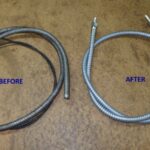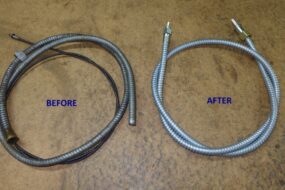Make sure you know where the fuse box is fitted in your car. The location is usually given in the car handbook. Often, the box is half hidden under the dashboard or in the front knee-well.
When an electrical component stops working the fault may be in the component, in the electrical circuit or in the fuse that protects them. Because the fuse is a likely cause, and the easiest to check, look at it first.
The fuses are usually grouped in a box or on a panel with a cover. Ideally, the box should be fixed in an accessible place — such as the bulkhead under the bonnet.
Often, however, it is hidden away, perhaps under the dashboard or down in the front knee-well.
The car handbook usually gives the location, but without a book finding the box can prove difficult. Get to know where it is before anything goes wrong.
The individual fuses in the box are usually numbered, so that sorting out which one may have blown is simplified by referring to the numbered list in the handbook. This should tell you which fuse protects which circuit.
Where they are not numbered, take out each fuse in turn and see which component stops working.
The type and construction of fuses varies from car to car.
A rectangular blade type. This is the most common type. It has two push-in connectors linked by a visible fuse wire.
A clear-glass type. A wire running through breaks when overloaded.
The continental type. A shaped metal strip set in one side melts under excessive load.
Checking fuses
Depending on the fuse design, it is sometimes possible to tell whether it has blown by holding it up against a light; a break in the wire inside may be visible. Another clue is blackening of the glass cover.
If there is no visible sign, check by fitting another fuse of the same rating; if that cures the trouble, then the fuse was to blame.
However, it is always advisable to check the circuit also, in case a fault in it caused the fuse to blow. For example, failure of an electrical component or damaged insulation on a cable can cause a short circuit, resulting in a sudden massive increase in current.
If the cable overheated, there could be a fire. The fuse prevents that happening, because its thin wire will melt and break the circuit long before the cable itself can heat up and burn.
Some cars have only two fuses. One rated at about 30-50 amps protects components wired through the ignition switch — flashers, wipers, heater-motor and instruments.
A fuse is ‘blown’ when the connector between its two ends melts under an overload of current.
The other, probably rated at about 20-30 amps, protects components not wired through the ignition — horns, interior lights and the cigarette lighter.
Where a single fuse protects a number of circuits and keeps blowing, each circuit must be checked individually to discover which one is faulty.
To find the faulty one, fit a sound fuse while all the relevant components are switched off. Now switch them on one at a time – the circuit with the fault will blow the fuse.
Always replace a fuse with one of the same rating. Replacing, say, a 10amp fuse with a 30amp one could result in considerable damage.
The 10 amp fuse would normally protect a circuit carrying 7 amps: a 30 amp fuse would allow a 30 amp current to flow through, with possibly a disastrous effect on the unit or cable it was supposed to protect.
Changing a fuse
Each fuse is held together between two clips in the fuse box; these are also the fuse contacts. The clips are sprung, and should hold the fuse tightly in place.
In most fuse boxes, the fuses simply push into a pair of spring-clip contacts.
Pull out the suspect fuse and, using fine emery paper, clean off any dirt or corrosion from the inside contact surfaces of the clips.
Make sure the new fuse has the correct amp rating for the circuit (See How car electrical systems work); use fine emery paper to brighten the metal caps at each end.
Use emerypaper to cleandirt andcorrosion fromthe clips.
Brighten the caps of a new fuse with emery paper. This will remove any tarnish that may have formed and ensure a good contact with the spring clips.
Push the fuse into the vacant clips and try the circuit to see if power is restored.
If it is not, check by fitting a fuse of the same rating from a circuit you know is working.
If this does not work, the fault is not in the fuse, but elsewhere in the circuit.
How fuses are marked
The amp rating is often stamped on the end cap of the fuse. Rating systems vary.
The amp ratings of all fuses are printed on them, but there are two systems of rating in use.
In the latest system, the rating marked on a fuse indicates the continuous current it can carry, while also withstanding brief surges of up to double that strength. It is usually called the CR (continuous resistance) rating.
A 10 amp fuse of this sort will carry a continuous 10 amps, and take brief surges up to 20 amps without blowing.
An earlier system marks the fuse with the maximum current it can carry before blowing – it will carry only half that figure continuously.
A 10 amp fuse of this sort will take a continuous load of 5 amps, and only short surges up to 10 amps, beyond which it blows.
Some fuse manufacturers are now marking fuses both ways. For instance, 20 amps (10 amps CR).
Types of line fuse
A line fuse with the fuse case hinged along its length.
Sometimes it is necessary to individually protect a circuit not covered by the main bank of fuses. For this, a manufacturer may use a line fuse.
A typical example is in BL cars where they are fitted to protect sidelight and tail-light circuits and the rear-window heater.
Mostly, however, they are used when an accessory such as a radio or a tape deck is being fitted – the fuse being linked into the power-supply lead near the set.
A line fuse in a screw-together plastic holder, with a bayonet-jointed fixed contact at one end and a spring-loaded contact at the other .
When the case sides snap together, they hold the fuse secure between the contacts.
A line fuse is simply a teo-part plastic holder with a terminal at each end. Each terminal is connected to an end of the cable, where it is cut to accommodate the fuse. One terminal is usually lightly spring-loaded to hold the fuse in contact.
The fuse fits between the two terminals and is held in place against the contracts by twist-locking or screwing together the two halves of the case.
The amp rating of a fuse protecting a radio or tape deck is specified by the markers of the equipment.
Thermostatic interruptor
A thermostatic interruptor acts like a fuse, but allows reduced power to essential circuits.
The sudden loss of headlights because a fuse has blown can be dangerous, so such circuits may be protected by a thermostatic interruptor.
This device is not quite a fuse, but works rather like one. It operates on the principle that a metal strip, when heated, bends away from a contact that it would normally be touching, and so breaks the circuit.
As the strip cools it returns to shape and touches the contact again, restoring the circuit.
If the headlight-circuit fuse blows. The thermostatic interruptor allows the lights to work on reduced power so that a journey can perhaps be completed. The lights and their circuit can be checked thoroughly later.
Thermostatic interruptions may also be fitted into circuits prone to occasional overloads.
A good example is a electric window-winder circuit; a jamming window could overload the winder motor, but a thermostatic interruptor stops the motor burning out and also eliminates the need for a conventional fuse.
A thermostatic interruptor not only protects the circuit, but also, like a fuse, serves as a warning that there is a fault in the circuit. Whenever an interruptor comes into operation, therefore, the related circuit should be checked thoroughly at the first opportunity.
Main lead tosolenoid
Fusible link
A fusible link fitted in the battery lead to the started solenoid protects all the car circuits in an emergency.
In certain modern cars, a special type of high-resistance fuse is fitted into the main battery feed – usually where it passes out of the starter solenoid.
Such a fuse is called a fusible link, and comprises lengths of copper wire of varying thicknesses between two two-pin plugs. The wires will melt in succession under a massive overload of current.
A fusible link with its wires melted by a current overload. After the fault has been remedied, a replacement link is plugged in.
A fusible link is fitted in addition to the normal bank of fuses, and is designed to protect all the electrical circuits in the car except the starter – which needs maximum power.
The protection it provides is invaluable if the car is in a crash and the wiring is crushed together or the insulation is chopped through.
The magnitude of the short circuit that could result is such that rapid overheating would almost certainly be followed by a fire.
However, a fusible link will melt even quicker – and break the circuit before that can happen.
If a fusible link has to be replaced, it needs very careful soldering to avoid damage by overheating. Generally the job is best left to an expert.







